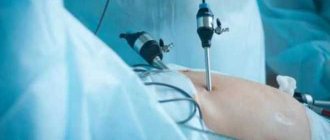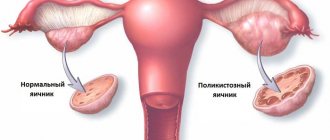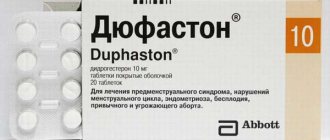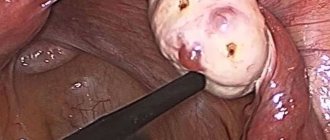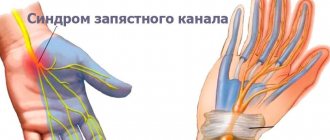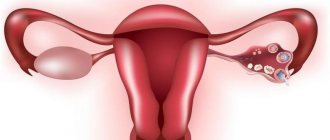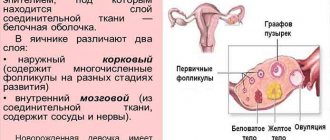IVF and PCOS
Currently, there are many methods for treating polycystic ovary syndrome, which include both non-hormonal methods of influencing the pathogenesis of this nosological form. So does powerful hormonal therapy. Also, to help expectant mothers who are so desperately fighting against fate, trying to get pregnant against all odds, there are laparoscopic technologies that, in a minimally invasive way, provide an 80% positive result in terms of pregnancy. But sometimes even such titanic efforts of both women and doctors turn out to be in vain. The only chance for future parents who do not lose hope is assisted reproductive technologies. The diagnosis of PCOS during IVF may present some complications that complicate the procedure. On the forums of gynecological patients, you can often come across the question “is IVF done for PCOS, who has succeeded?” Answer: they definitely do. But as with any intervention, IVF requires certain indications.
- IVF and PCOS: indications for in vitro fertilization.
- Lack of desired pregnancy with a diagnosis of polycystic ovary syndrome with a confirmed absence of ovulation for one and a half years;
- Lack of pregnancy after stimulation of ovulation with clostilbegit, clomiphene.
- Lack of conception due to laparoscopic surgery in the form of laparoscopic drilling, fenestration, wedge resection of the ovary.
This procedure requires careful preparation of a woman diagnosed with polycystic ovaries, as there are hormonal disorders that are characteristic of this pathological condition. PCOS and IVF: what are the chances? If certain rules are followed, the chances of IVF for PCOS are quite high.
First of all, before carrying out the in vitro fertilization procedure, it is necessary to recommend that the woman reduce her body weight, if she is overweight, by reviewing the details of the pregnant woman’s diet and reducing the proportion of carbohydrates in it, focusing on protein foods. Increase physical activity in the form of swimming, brisk walking, cycling. When insulin resistance is confirmed, a hypoglycemic drug is used - metformin and its derivatives.
Monitoring the hormonal levels of the expectant mother is mandatory, since gross changes in the hormonal balance can simply negate all efforts to achieve the cherished goal of conceiving a child. Since pregnancy is a rather complex hormonal change in the body, which can be disrupted by even the most insignificant, at first glance, factors.
A fairly common phenomenon that can have a negative impact on the IVF protocol and the pregnancy itself is hyperprolactinemia - an increased level of prolactin. When this fact is confirmed, special drugs are prescribed, such as Bromocriptine, Parlodel.
For hyperandrogenism, that is, increased testosterone levels, dexamethasone is prescribed.
Causes of PCOS
Among the causes of PCOS are dysregulation of follicle maturation, as well as changes in enzyme systems involved in the biosynthesis of ovarian androgens (male hormones in the female body), which can lead to an imbalance between the process of cell division and reverse development of cells (apoptosis) of ovarian tissue. In addition, the role of genetic factors that can disrupt the regulation of cytochrome P450c17, a key enzyme in the biosynthesis of ovarian and adrenal androgens, is not denied. It is important to note that PCOS often develops against the background of neuroendocrine syndromes, obesity, hyperprolactinemia, congenital adrenal dysfunction, and Cushing's disease. Such women often experience menstrual irregularities, excess weight, increased insulin levels in the blood, impaired glucose tolerance and type 2 diabetes.
Is it possible to do IVF with polycystic ovary syndrome?
The process of carrying out the in vitro fertilization protocol includes such a stage as ovulation stimulation.
The most dangerous complication that often occurs in patients with polycystic ovary syndrome is ovarian hyperstimulation syndrome. Even small doses of gonadotropins, which are prescribed to stimulate ovulation, cause an excessive ovarian response. Under their influence, many small follicles develop in the ovaries, which do not reach the dominant stage. As a result of this, women with polycystic ovary syndrome are always included in the risk group for this complication during the in vitro fertilization protocol.
In addition, such women often have a reduced ovarian response to stimulation drugs such as clostilbegit (also known as clomiphene). Therefore, for stimulation, drugs of the gonadotropin group are used, which contain either follicle-stimulating hormone, luteinizing hormone or only FSH.
Also for this purpose, drugs of the group of gonadotropin releasing hormone agonists (Zoladex), as well as antagonists, are used. The use of the latter drugs reduces the risk of developing ovarian hyperstimulation syndrome and is recommended for inducing ovulation in women with PCOS.
How does stimulation work?
Before treatment, it is necessary to exclude other possible causes of infertility. For this purpose, women are additionally prescribed diagnostic tests for the patency of the fallopian tubes, and men are given a spermogram. Carrying out the procedure with partial or complete obstruction of the tubes may pose a risk of ectopic pregnancy.
Repeated ultrasound monitoring of the condition of the ovaries is first necessary. To do this, an ultrasound is performed on the 8-10th day of the cycle, and then repeated every 2-3 days until it is determined that ovulation has occurred or the onset of menstruation.
The presence of disruptions in the development of follicles is not always an indication for stimulation. If the follicle reaches the size necessary for conception, but does not rupture, hCG injections are sufficient to solve the problem. Correction of ovulation is necessary if the follicle does not develop or does not reach the required size.
After ultrasound and blood tests necessary for an accurate diagnosis, treatment begins. Stimulation of ovulation is a fairly lengthy process. Treatment includes:
- restoration and normalization of the menstrual cycle;
- equalization of hormonal balance;
- weight adjustment (if necessary);
- strengthening immunity and general health.
The comprehensive implementation of the mentioned measures will create favorable conditions for successful conception.
Drug stimulation
All drugs for stimulating ovulation in polycystic disease are hormonal drugs and differ only in the type of hormone. Typically, the treatment regimen includes the use of several types of drugs.
The procedure can be carried out only when a scheme is developed by a doctor and under his supervision. Regular ultrasound monitoring is also necessary.
Therapy with Clostilbegit
Clostilbegit is a non-steroidal anti-estrogenic agent that accelerates the process of follicle maturation. The active substance is clomiphene citrate. It can be prescribed not only to women, but also to men to improve sperm quality. Release form: tablets for oral administration.
It is very important to follow a clear dosage regimen. If a woman has a regular menstrual cycle, start taking the drug on the 5th day of the cycle. For irregular periods, the start of treatment does not matter.
The starting dosage is 50 mg taken at night for five days. From 7-11 days, ultrasound monitoring is carried out in order to track the growth of follicles and the condition of the endometrium. If the treatment results are positive, ovulation occurs approximately on days 11-15 of the cycle.
If the treatment does not produce a positive result, the dosage of the drug is increased to 100 mg (2 tablets) per day and continued administration. Maturation of the egg is the basis for discontinuing the drug, but if ovulation does not occur again, a break of three months is necessary. The total dosage for the entire duration of therapy should not exceed 750 mg. In most cases, a positive result is noted after the first course.
Stimulation with Menopur
Menopur is a hormonal drug based on follicle-stimulating and luteinizing hormones in a 1:1 ratio. Release form: ampoules. In addition to ampoules with hormones, the kit includes an ampoule with a solvent for preparing the injection.
At the beginning of treatment, intramuscular injections are prescribed daily with a dosage of 75 IU (1 bottle per day). At each dose you need to prepare a new solution. If there is no result, the dosage is increased until the amount of estrogens begins to increase and returns to normal.
The drug is well tolerated and gives positive results, however, before its administration, the patient must undergo a full examination. During use, a state of ovarian hyperstimulation may occur. In this case, treatment should be stopped.
Reception of Gonal
A drug with a gonadotropic effect that stimulates the development of follicles. Gonal belongs to powerful drugs; it can be prescribed in cases where other drugs have not given the expected result.
Release form - powder or a special syringe pen with a ready-made solution. The second option is much more convenient, since it does not require calculations before preparing the solution, does not cause pain or discomfort during administration, and allows for self-administration.
The course lasts about a month. It must be accompanied by ultrasound monitoring of the development and condition of the follicles. As soon as the follicle reaches the desired size, the patient is given an injection of hCG to disrupt its integrity. A day after the injection, ovulation occurs, which in 95% of cases leads to pregnancy.
Before IVF
IVF is a modern method of overcoming female infertility as a result of endometriosis or obstruction of the fallopian tubes. Fertilization of the female egg occurs outside the mother's body artificially, and then the embryo is transferred into the uterine cavity.
If pregnancy is prevented by the absence of ovulation, it is stimulated. Typically, the stimulation process begins on days 3-5 of the cycle. The drugs are administered intramuscularly or subcutaneously; it is also possible to prescribe tablets with an anti-estrogenic effect. After the follicle matures and an injection of hCG is administered to rupture it, ovulation occurs.
The treatment regimen and selection of medications are carried out exclusively by a fertility specialist; the stimulation process is carried out under ultrasound control.
PCOS: Is IVF always successful the first time?
If we take into account the serious consequences that stimulation entails, then in such cases, it is recommended that the woman resort to a single stimulation, and then use the services of cryopreservation in order to preserve high-quality, viable embryos. This is done for the following reason: it is no secret to anyone that not all women succeed in achieving pregnancy on the first attempt at in vitro fertilization, and each subsequent attempt increases the chances of this. But for women diagnosed with PCOS, such actions, which involve repeated stimulation, are undesirable. It is to exclude them that cryopreserved embryos will be used in the next protocol. And it is also possible to use the IVF service in a natural cycle, which is a cheaper procedure. You can also use a procedure such as insemination for PCOS; IVF can be the next step if the previous one is ineffective.
Statistics know many happy cases of those who succeeded in IVF with PCOS; the chances of getting the desired pregnancy if the requirements are strictly followed are high.
Thus, we can note the fact that the doctor who will carry out the extracorporeal research protocol must weigh all the indications and contraindications, choose the optimal method of ovarian stimulation, stop at the moment with the help of which ovulation stimulation protocol, long or short, he will perform the stage, and also provide accessible information regarding the advantages of embryo cryopreservation. All symptoms regarding ovarian hyperstimulation syndrome should also be explained so that every woman who has undergone ovulation stimulation can pay attention in time to the initial symptoms of this pathological process and promptly seek qualified medical help.
IVF for PCOS: what you need to know?
Every woman who is diagnosed with PCOS and decides to undergo IVF should know that the in vitro fertilization procedure has its own difficulties and features. The menstrual cycle must be completely restored, otherwise there is no point in IVF. There will be no positive results even in the initial stages.
Also, the patient must have a normal weight, and this is very rare with PCOS, since this disease provokes metabolic disorders that lead to obesity. Therefore, a woman must go on a special diet that will allow her to bring her weight back to normal.
It has been proven that those women who managed to reduce their body weight by 7% or more are more likely to achieve positive results from IVF than those who were not able to do this.
IVF for polycystic ovary syndrome: reviews
A large contingent of women with a variety of gynecological and extragenital pathologies turn to reproductive doctors. Polycystic ovary syndrome is no exception.
In most cases, the in vitro fertilization protocol in women with signs of polycystic disease takes place without any complications.
Women who leave reviews of IVF for PCOS, in 70% of cases, say that they have not experienced any complications or side effects from using the in vitro fertilization protocol. However, there are statistical observations that in the majority of women who left reviews, ovulation was stimulated with small doses of gonadotropins or antagonists. It has already been noted that the use of these drugs is more effective and safe in patients with this diagnosis. About 20% of women who underwent IVF with PCOS left reviews about a slight deterioration in their general condition, minor nagging pain in the lower abdomen, and a feeling of discomfort. However, over time, such symptoms of mild malaise were eliminated and the general condition returned to normal.
But in about 10% of reviews you can find fairly clear descriptions of the symptoms, which represent the clinical picture of ovarian hyperstimulation syndrome. Women describe their complaints of fairly severe pain in the lower abdomen, a feeling of nausea, vomiting; in 3% of these women, there was an accumulation of fluid in the abdominal cavity - ascites. The women have experienced a rather unpleasant state and just the thought of repeating such stimulation brings significant psychological discomfort. It is precisely in order to avoid repeated stimulation procedures that women with polycystic ovary syndrome use embryo cryopreservation. Women note that they tolerate the IVF procedure well without stimulation, especially since, in the absence of contraindications, it can be carried out in a natural cycle, which also reduces the amount of medications received.
Only a qualified fertility specialist chooses the necessary IVF protocols for PCOS, the reviews of which receive very positive reviews. If you have a diagnosis of polycystic ovaries, it is very important to consult a doctor, undergo an examination and carry out a protocol in accordance with all rules and recommendations.
Causes of polycystic ovary syndrome
Prolactin influences the normal functioning of the ovaries. Prolactin is a hormone that is responsible for lactation. During constant stress, its level increases, which can lead to disruption of the ovaries.
The note
If you do not go to the hospital in time, infertility may develop in the future.
Doctors still cannot determine the cause of this disease. Pathology may begin to develop due to a malfunction in the hypothalamus-pituitary-adrenal-ovarian system. The cause may be a malfunction of the thyroid gland.
Difference between ovaries in polycystic and normal ovaries
The main factors that contribute to the development of pathology:
- Endocrine disorders or inflammatory processes in the genital organs;
- Living in environmentally polluted parts of the city;
- Diseases of the pancreas and thyroid gland;
- Regular sex life;
- Too frequent abortions;
- The presence of chronic infections in the body;
- Stresses;
- Overweight;
- The disease is transmitted at the gene level.
